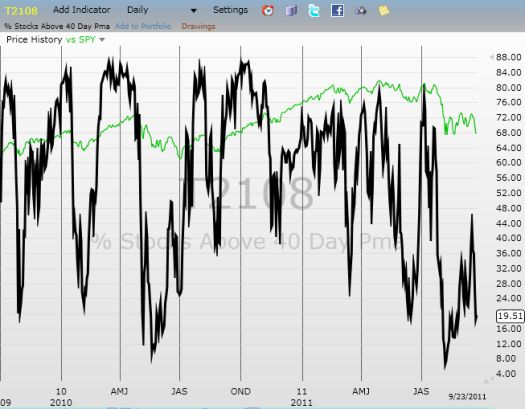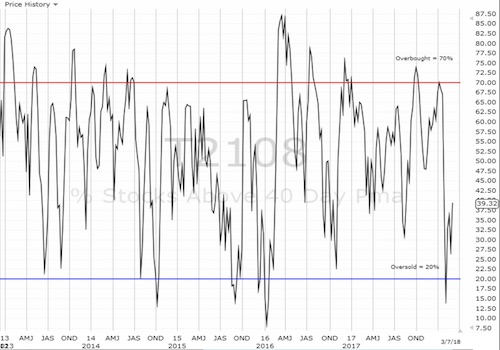(T2108 measures the percentage of stocks trading above their respective 40-day moving averages [DMAs]. To learn more about it, see my T2108 Resource Page.)
T2108 Status: 29% and neutral.
VIX Status: 21.
General (Short-term) Trading Call: Hold.
Commentary
When I finally decided to start generating posts dedicated to T2108, I thought I would produce a post or two a week on the indicator. Instead, I have posted almost daily for several months now as T2108 has spent an inordinate amount of time first loitering around overbought levels, and now loitering around oversold levels. These parallel experiences of churn have compelled me to stay creative, flexible, quick and willing to change my assessments.
I mention this context because just as I got increasingly bearish the longer the market kept falling into and out from overbought territory, I will get more bullish the longer the market falls into and out from oversold territory. The key adjustment will be to think of longer time-frames for the trades, particularly fewer options and more shares. I will also have to hedge more than I would like.
The overall trends will be critical as well. For example, if the S&P 500 closes at new lows for 2011, it will suddenly print a much more ominous short-term downtrend. Under such a scenario, oversold can stay oversold for quite some time as the market enters a strong trend. (Fifty-six percent of all oversold periods last one or two days. The average oversold period lasts six days. Eighty percent of all oversold periods end within nine days, and 90 percent end within 10 days). At that point, buying will get more treacherous and watching the volatility index (VIX) will become even more important. (For more details see “Trading the Oversold Bounce” – free registration required).
Ironically, shorting could also become more treacherous; when the market is oversold, particularly strong bounces and relief rallies can happen at any time on any positive crumb of news. If a trader is not prepared, s/he can lose money getting constantly stopped out of positions only to re-enter once the selling resumes. Accordingly, when going short, risk is often best managed by waiting for confirmation of bearish moves rather than trying to move in advance of them (the same rules apply if a trader insists on opening fresh bullish trades when the market is overbought).
Yesterday, I posited that the market had washed out a second wave of sellers but that the “tail” on the chart was likely too long to serve as strong support. Unfortunately, the pushback almost took the index to yesterday’s lows – a performance much worse than I was expecting. As a result, all eyes return to the key support lines: the 200DMA and the 2011 closing lows from March.
Finally, I also stated that I believed a bullish divergence had occurred with the volatility index pushing into territory last visited in the previous oversold bounce without T2108 returning to oversold. The exact opposite may be the true implication (that is, a bearish divergence implying an imminent return to oversold conditions). I am duly noting a need to study the historical record on the potential relationship here.
Charts below are the latest snapshots of T2108 (and the S&P 500)
Refresh browser if the charts are the same as the last T2108 update.
Daily T2108 vs the S&P 500

Black line: T2108 (measured on the right); Red line: S&P 500 (for comparative purposes)
Weekly T2108

*All charts created using TeleChart:

Related links:
The T2108 Resource Page
Expanded daily chart of T2108 versus the S&P 500
Expanded weekly chart of T2108
Be careful out there!
Full disclosure: long SSO puts, long VXX puts
